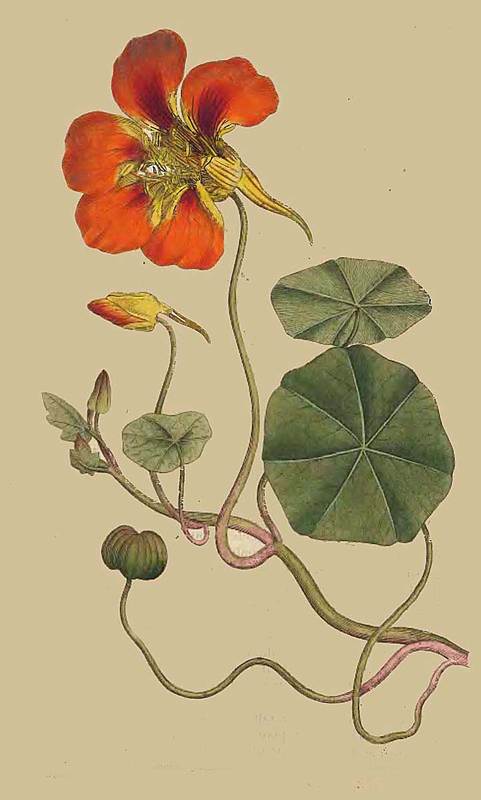23. Tropaeolum majus. Greater Indian-Cress, or Nasturtium.
Description
This section is from the book "The Botanical Magazine; Or, Flower-Garden Displayed", by William Curtis. Also available from Amazon: The Botanical Magazine; or, Flower-Garden Displayed, Volume I.
23. Tropaeolum majus. Greater Indian-Cress, or Nasturtium.
Tropaeolum majus. Greater Indian-Cress, or Nasturtium.
Class and Order:
Octandria Monogynia.
Generic Character:
Calyx 1-phyllus, calcaratus. Petala 5 in aequalia. Baccae tres, siccae.
Specific Character and Synonyms:
TROPaeOLUM majus foliis peltatis subquinquelobis, petalis obtusis. Lin. Syst. Vegetab. ed. 14. Murr. p. 357. Sp. Pl. p. 490.
CARDAMINDUM ampliori folio et majori flore. Grande Capucine Tournef. Inst. p. 430.

The present plant is a native of Peru, and is said by Linnaeus to have been first brought into Europe in the year 1684; it is certainly one of the greatest ornaments the Flower-Garden can boast: it varies in colour, and is also found in the Nurseries with double flowers. The former, as is well known, is propagated by seed; the latter by cuttings, which should be struck on a hot-bed. To have these plants early, they should be raised with other tender annuals; they usually begin to flower in July, and continue blossoming till the approach of winter: the stalks require to be supported, for if left to themselves they trail on the ground, overspread, and destroy the neighbouring plants.
Elizabeth Christina, one of the daughters of Linnaeus, is said to have perceived the flowers to emit spontaneously, at certain intervals, sparks like those of electricity, visible only in the dusk of the evening, and which ceased when total darkness came on.
The flowers have the taste of water-cress, with a degree of sweetness, which that plant does not possess, more particularly resident in the spur of the calyx or nectary; hence are sometimes used in sallads, and hence the plant acquires its name of Nasturtium.
Continue to:


